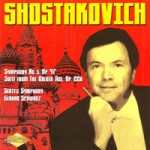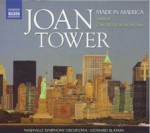Column Name
Title
Shostakovich: Symphony No. 5; Suite from The Golden Age (Op. 22a). Seattle Symphony, Gerard Schwarz, conductor. (Artek AR-0037-2)
Body
Two veteran American conductors, both Juilliard-trained, have made two splendid new recordings, one of which confirms the existence of a substantial orchestra in the heart of Tennessee. First, from the West Coast, a new Artek disc from Gerard Schwarz (B.M. 1972, M.M. 1990 trumpet) reveals that the searing Fifth Symphony of Shostakovich can assume a more lyrical guise than it is usually given. With lush playing from the Seattle Symphony, helped by the burnished acoustic of Seattle’s Benaroya Hall, Schwarz brings the composer closer to Glinka or Rimsky-Korsakov. Edges are soft but not pallid, tone is pleasantly full but doesn’t sacrifice clarity, and there is always an emphasis on the score’s inky hues.
Schwarz adopts relaxed tempi in the opening moderato, but ups the temperature slightly with more sunlight in the allegretto. The great largo shows the plush and velvet of the Seattle winds in some mesmerizingly soft solos, balanced by heartbreaking weight from the cellos and basses, in what Schwarz presents as the symphony’s core. Tiny details and minute dynamic gradations only add to the desolation, as the orchestra lands like a dove on the final haunting chord. Schwarz then unleashes cascades of sound in the final allegro non troppo, again with less angst than in some renditions, but this is the beauty of this composer. The reading offers its own majestic view, and joining Shostakovich on a mountaintop isn’t a bad way to spend an afternoon.
The suite from The Age of Gold (L’age d’or, Op. 22a), recorded a year later, has a little more bite, and even fuller sound. (Albert G. Swanson is the engineer for both works.) The Seattle winds show their mettle introducing the opening allegro non troppo, which moves swiftly into passages marked by the composer’s characteristic swagger. Listeners might never guess that the sweetly poignant second movement is intended to evoke fascist dancers’ attempts to seduce a soccer captain (according to the composer in Stephen Lowe’s liner notes). The richly textured string passages framing a winsome saxophone solo feel like outtakes from An American in Paris. In the witty Polka, with one of the best-known showcases for the xylophone, Schwarz chooses moderation—a waddle instead of a mad dash to the finish line—and his drollery works, highlighting the skeletal orchestration. And in the surprising tumult of the final allegro he revels in an athletic dance with brass-happy accents.
Joan Tower: Made in America, Tambor, Concerto for Orchestra. Nashville Symphony, Leonard Slatkin, conductor. (Naxos 8.559328)
Joan Tower’s Made in America (2005), a fantasy based on “America the Beautiful,” was one of the first commissions of a consortium of 65 American orchestras, which performed it in all 50 states in less than two years. For the Naxos recording, the Nashville Symphony Orchestra sets the pace with Juilliard alum Leonard Slatkin (B.M. 1967 orchestral conduct) encouraging the group to demonstrate its expertise and color (evidenced particularly by its bang-up percussion section) and showing that the East and West Coasts of the U.S. have no monopoly on lucid orchestral playing.
Shostakovich might have admired the ease with which Tower handles percussion in Tambor (1998), a work that bristles with a maniacal drive, and the 1991 Concerto for Orchestra, teeming with virtuoso writing for every member of the ensemble. She opens with a flute motif that evokes Bartok’s famous opus, but the languid air quickly becomes an avalanche of punishing climaxes. With echoes of Stravinsky and John Adams, Tower, who was the first woman ever to receive the Grawemeyer Award in composition in 1990, creates an adrenaline-pumping canvas with propulsive rhythms taking center stage. I could feel my heart racing during the furious conclusion.
Engineer Tim Handley has expertly captured the luxurious sound of the ensemble in its new home, Nashville’s Schermerhorn Symphony Center, with a pleasing resonance that allows details to emerge while still conveying Tower’s massive architecture. Slatkin, who was just named music director of the Detroit Symphony Orchestra beginning with the 2008-09 season, draws playing as memorable as that of any orchestra anywhere, setting a high bar for a well-crafted work that is likely to find itself played often.






